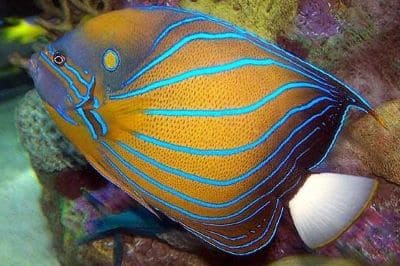Home › Sea Life › Marine Animals › Vertebrates › Angelfishes › Bluering Angelfish
Blue-ringed Angelfish Facts and Information
[Phylum: Chordata] [Class: Actinopterygii] [Order: Perciformes] [Family: Pomacanthidae]
Most of the angelfish phylum are aesthetically pleasing to look at. But, the curves of neon blue lines in the species named annularis catches the eye of its onlookers.
This section contains fun facts and interesting information about the blue ring angelfish, including where they live, what they eat, and how they reproduce.
Pomacanthus Annularis Habitats and Range
There are more than eighty (80) different species of angelfish living in tropical saltwater environments.
Large marine angelfish live around shallow reefs and sunken wrecks in the Indian, Atlantic, and Pacific Oceans.
Angelfishes and butterflyfishes rank among the most conspicuous of all vertebrate animals that inhabit coral reef formations (e.g. atolls).
The biggest angelfish are quite bold in their natural habitat. They often swim close to scuba divers and skin divers.
Pro Tip: Angelfish classification differs in taxonomy for "Cichliformes" (tropical cichlids) and "Pterophyllum fish" (freshwater angelfish) - often kept in captivity by aquarist fish keepers.
Blue Ring Angelfish Characteristics
Despite being closely related to butterflyfish (family Chaetodontidae), ocean angelfish have stronger facial support from preopercle bones. These robust "boomerang-shaped" structures are gill covers that help them to breathe and feed.
Almost all angelfishes are a hardy and bold species when swimming around the reef. But, they become more timid and seek shelter in rocky crevices when darkness falls.
Here's the thing:
The features that stand out the most with adult blue-ringed angelfishes are the curved blue lines and yellow body colouring.
 But, their name "annularis" actually comes from the "ringed" blue circle situated slightly above the gill cover.
But, their name "annularis" actually comes from the "ringed" blue circle situated slightly above the gill cover.
When fully matured, the adults also have an elongated dorsal fin tip with a white caudal fin, often with a yellow tint around the margin.
They have thirteen (13) spines on the dorsal fin, with up to twenty one (21) soft rays. The anal fin has three spines and twenty soft rays.
Despite having a small mouth, bluering angelfish can grow to forty five (45) centimetres long (18 inches).
Pro Tip: During the early development of blue-ringed angelfish, the juveniles tend to have a blue-black body with narrow, pale white curved bars on their body.
What Do Blue-Ringed Angelfish Eat?
The classification of angelfish defines their individual feeding habits. For example, marine angelfishes of the family Pomacanthidae (also called swallowtail or lyretail angelfish) are typical planktivores (e.g. they feed on planktonic organisms, filamentous green algae, and zooplankton in the water column).
Whereas, a staple food source for most of the large angelfish species includes benthic invertebrates (crustaceans, marine worms), bryozoans (moss animals), hydroids, sea sponges, and salpa (barrel-shaped tunicates).
How Do Bluering Angelfish Reproduce?
A pronounced shift in colouration combines with maturity and social ranking for many of the angelfish phylum. Put another way, the characteristics of juvenile angelfishes see a dramatic change and colour shift as they develop into adulthood.
Blue ring angelfish are protogynous hermaphrodites, meaning females change their gender to become a functional male if the dominant male dies or is removed from the harem.
But wait - there's more:
Angelfishes are pelagic spawners. Hence, they release between 150 and one thousand miniscule buoyant eggs into the water column.
The eggs float around with plankton in ocean currents until they hatch. As a consequence of that, most of them fall victim to a range of planktonic feeders, such as large marine mammals.
Threats and Predators
Saltwater angelfish have several natural predators, especially barracudas, large open ocean fishes, and most of the shark phylum.
Are Angelfish Poisonous?
Some large angelfish are edible and fished for human consumption for food. But, caution is needed because some species are not safe to eat and may cause a foodborne illness called ciguatera poisoning. Moreover, ciguatoxin has similar symptoms to pufferfish poisoning.
Pro Tip: The IUCN Red List of Threatened Species last assessed many of the angelfish phylum in 2009. They cited blue ring angelfishes (Pomacanthus annularis) as being of "Least Concern" (LC).
Related Information and Help Guides
- Cardinal Fish Facts and Species Information
- Lemonpeel Angelfish Fun Facts and Information
- Goby Fish Facts and Interesting Information
- Marine Vertebrates with Examples and Pictures
- Wrasse Fish Species Interesting Information
Note: The short video [2:59 minutes] presented by "Deep Marine Scenes" contains footage of a colourful and territorial coral reef fish known as marine angelfishes (Pomacanthidae).